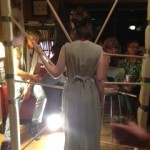 Private homes have long been the locus of some of the most interesting arts experiences, from providing a backdrop for the debut of Schubert song cycles to honoring the work of the New York-based experimental theatre company Banana Bag and Bodice.
Private homes have long been the locus of some of the most interesting arts experiences, from providing a backdrop for the debut of Schubert song cycles to honoring the work of the New York-based experimental theatre company Banana Bag and Bodice.
The reasons for this are diverse: Private homes allow for art to be seen without necessarily being judged in an atmosphere that’s supportive. The work presented doesn’t have to be full or complete — it is commonly “in progress”. The emphasis is as much on the social experience as it is on the arts experience, creating an atmosphere that is relaxed and less intimidating for most artists than a public space. The setup allows for easy conversations about the work which often helps artists with their developmental process. Lastly, the costs of mounting an arts event in a private home are relatively modest compared to a full no production in a concert hall, museum or theatre.
In the Bay Area, home-based arts events have been going on all over the place for years. One of the most lively, eclectic and inventive of these happenings I’ve experienced is the Franconia Performance Salon, which I attended for the first time on Saturday night.
The salons happen every few weeks at the home of the theatre director and Stanford faculty member Michael Hunter. Hunter lives in a quirky-expansive hilltop home in the Bernal Heights neighborhood of San Francisco. With its high ceilings, big walls, and natural staging and viewing areas (e.g. a sweeping staircase and gorgeous outdoor patio), the house makes for the ideal space to interact with art.
About 50 people, aged, at a guess, between 20 and 60, attended the salon on Saturday. The room was alive with conversation about a wide variety of topics, ranging from the 9/11 attacks on the World Trade Center (inspired by the viewing of a blurry short film by Kiki Valentine on the subject) to the use of chest voice in American musical forms like shape note singing (inspired by a robust performance of a Bulgarian close harmony song by a trio of fresh-faced twenty-somethings hailing from Denmark, Poland and the US.)
Other artistic offerings included several strangely compelling performance art pieces with their roots firmly in the 1960s.
Perhaps the most throwback-y offering involved a naked young woman lying on her back on an animal pelt. She was touching crowns with a young man dressed in dirty long-johns, who had his right forefinger stuck in his exposed belly button, his left grasping an ax and his feet covered in mud. Oh, and there were flower petals scattered over his chest. The couple lay motionless for the best part of an hour as people stood over them chatting with their hands full of wine and snacks. (Hunter provides delicious food and drink for his events and attendees each make a suggested donation of $10 to cover the costs.)
Another performance involved a young woman standing still while another performer cut up long pieces of wood and used them to “pin” her partner in a wooden frame that was part of the architecture of the main room in the house. After each piece of wood had been added, making the stationary performer resemble a Medieval Madonna surrounded by rays of heavenly light, she burst out of her confines and the wood clattered to the floor. It was a beautiful theatrical moment of disruption.
And in yet another short piece, one performer used a flashlight to project shadows of dollhouse furniture on to a large piece of white paper pinned to a wall while another performer used a black pen to trace the outlines of the furniture to eventually create a drawing in black and white of a room. Then the draughts-woman sat down in front of the canvas and started eating a bunch of flowers that had been sitting in a vase on the floor throughout the drawing process. Finally, the two artists beckoned audience members to come up to the front, kneel down and eat flowers. They tasted quite bitter, but I was rather hypnotized by the whole thing.
